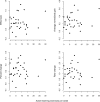Active learning not associated with student learning in a random sample of college biology courses
- PMID: 22135373
- PMCID: PMC3228657
- DOI: 10.1187/cbe.11-07-0061
Active learning not associated with student learning in a random sample of college biology courses
Abstract
Previous research has suggested that adding active learning to traditional college science lectures substantially improves student learning. However, this research predominantly studied courses taught by science education researchers, who are likely to have exceptional teaching expertise. The present study investigated introductory biology courses randomly selected from a list of prominent colleges and universities to include instructors representing a broader population. We examined the relationship between active learning and student learning in the subject area of natural selection. We found no association between student learning gains and the use of active-learning instruction. Although active learning has the potential to substantially improve student learning, this research suggests that active learning, as used by typical college biology instructors, is not associated with greater learning gains. We contend that most instructors lack the rich and nuanced understanding of teaching and learning that science education researchers have developed. Therefore, active learning as designed and implemented by typical college biology instructors may superficially resemble active learning used by education researchers, but lacks the constructivist elements necessary for improving learning.
Figures



References
-
- Allen D, Tanner K. Answers worth waiting for: one second is hardly enough. Cell Biol Educ. 2002;1:3–5. - PubMed
-
- Anderson DL. PhD Dissertation. San Diego, CA: University of California and San Diego State University; 2003. Natural selection theory in non-majors biology: instruction, assessment, and conceptual difficulty.
-
- Anderson DL, Fisher KM, Norman GJ. Development and evaluation of the conceptual inventory of natural selection. J Res Sci Teach. 2002;39:952–978.
-
- Andrews TM, Kalinowski ST, Leonard MJ. “Are humans evolving?” A classroom discussion to change student misconceptions regarding natural selection. Evol Educ Outreach. 2011;4:456–466.
Publication types
MeSH terms
LinkOut - more resources
Full Text Sources

